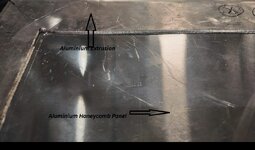KVARM
Mechanical
- Aug 27, 2018
- 15
Hello,
I am seeking a welding expert to assist with a project involving an Aluminium honeycomb panel with Aluminium extrusion.
Specification:
I am considering several welding methods for this application:
Thank you for your time and consideration. I look forward to your valuable input.
I am seeking a welding expert to assist with a project involving an Aluminium honeycomb panel with Aluminium extrusion.
Specification:
- Honeycomb Panel Dimensions: 45 mm Height, core bonded with glue
- Top and Bottom Skin Thickness: 1 mm
- Extrusion Type: C-Type
- Extrusion Thickness: 3 mm
- Welding Requirement: Four-side edge welding of extrusion to honeycomb panel
I am considering several welding methods for this application:
- Laser Beam Welding (LBW)
- Electron Beam Welding (EBW)
- Friction Stir Welding (FSW)
- TIG/MIG Welding
Thank you for your time and consideration. I look forward to your valuable input.

